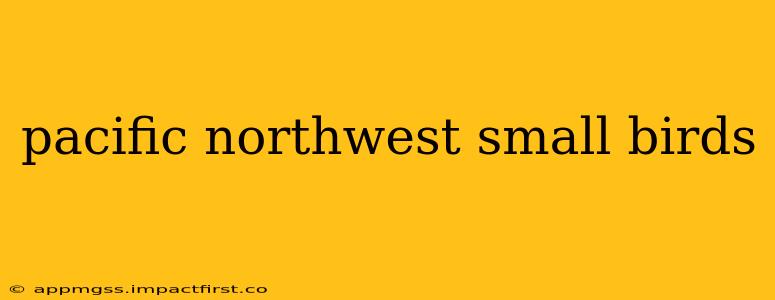The Pacific Northwest, with its lush forests, diverse wetlands, and varied coastal habitats, is a haven for a multitude of bird species. While spotting majestic eagles and owls is thrilling, the region's smaller avian inhabitants often steal the show with their vibrant colors, intricate songs, and fascinating behaviors. This guide dives into the world of Pacific Northwest small birds, exploring common species and addressing frequently asked questions.
What are some common small birds in the Pacific Northwest?
The Pacific Northwest boasts a rich diversity of small birds. Some of the most common species you'll encounter include:
- Anna's Hummingbird: Known for its iridescent green back and rufous gorget (throat patch), this hummingbird is a year-round resident in many areas.
- Rufous Hummingbird: A smaller, more energetic hummingbird, the rufous is a summer visitor known for its bright orange-rufous coloring.
- Downy Woodpecker: This small woodpecker is identifiable by its black and white plumage and small size, often seen in forests and woodlots.
- Hairy Woodpecker: Slightly larger than its Downy cousin, the Hairy Woodpecker shares a similar appearance but boasts a longer beak.
- Northern Flicker: While not strictly "small," this woodpecker's size relative to other larger birds, along with its frequent presence in urban areas, places it in many backyard birdwatchers' minds.
- Chestnut-backed Chickadee: A tiny, cheerful bird with a black cap and chestnut back, this chickadee is a year-round resident.
- Black-capped Chickadee: Similar to the Chestnut-backed, but with a black back, these are widespread throughout the region.
- Bushtit: These tiny, active birds are masters of camouflage, blending seamlessly into shrubs and trees.
- Ruby-crowned Kinglet: A tiny, active bird with a hidden ruby-red crown, often seen flitting through treetops.
- Golden-crowned Kinglet: Another tiny kinglet, this one shows off a bright golden crown patch.
What are the smallest birds in the Pacific Northwest?
The Bushtit and the Kinglets (Ruby-crowned and Golden-crowned) are among the smallest birds regularly found in the Pacific Northwest. Their diminutive size allows them to navigate dense foliage with ease.
Where can I find small birds in the Pacific Northwest?
Small birds inhabit a variety of habitats throughout the Pacific Northwest. You can find them in:
- Forests: Both coniferous and deciduous forests provide ample food and nesting sites.
- Woodlands: Wooded areas, even in urban parks and gardens, can host a variety of small bird species.
- Wetlands: Areas with water sources, such as marshes and swamps, attract species that depend on insects and aquatic life.
- Coastal areas: Beaches, bluffs, and coastal forests support unique species adapted to coastal environments.
- Gardens: Attracting small birds to your backyard is possible with native plants, bird feeders, and clean water sources.
How can I identify small birds in the Pacific Northwest?
Proper identification requires careful observation. Key features to consider include:
- Size and shape: Note the overall size and body proportions.
- Plumage: Pay close attention to the color and pattern of the feathers.
- Behavior: Observe their foraging habits, calls, and movements.
- Habitat: Knowing the location where you spotted the bird can narrow down the possibilities.
- Field guides: Utilizing a reputable field guide, either physical or digital, is essential. Many excellent resources are available specifically for Pacific Northwest birds.
What are some good resources for identifying Pacific Northwest birds?
Many online and print resources exist to aid in identifying Pacific Northwest birds. These include:
- Local Audubon Societies: These organizations often offer workshops, guided bird walks, and online resources.
- eBird: This online database allows users to record their bird sightings and access information about bird distribution.
- Field guides: Several excellent field guides are specifically tailored to the Pacific Northwest.
What is the best time of year to see small birds in the Pacific Northwest?
While many species are present year-round, spring and fall migrations bring increased bird diversity. Spring offers the spectacle of breeding plumage and songs, while fall migration offers a chance to spot species that breed further north.
This comprehensive guide provides a starting point for your exploration of the fascinating world of small birds in the Pacific Northwest. Remember that responsible birding practices are essential. Observe birds from a respectful distance, avoid disturbing their nests, and appreciate the beauty of these tiny creatures in their natural environment.
